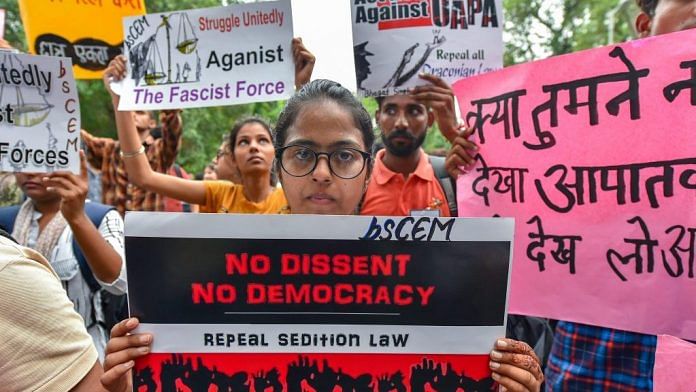The case against climate activist Disha Ravi and others, contained in the pages of the bulky chargesheet hauled into court in a steel box, hinges on a single factor — what constitutes sedition?
Whether the acts of university students inside their campus in February 2016
amounted to subversion of the government by inciting a violent “revolution”?
The law of sedition is authoritatively decided in the five-judge Constitution Bench judgment
of the Supreme Court in Kedar Nath Singh versus State of Bihar in 1962.
The law declared by the Bench still holds true but is seldom seen to be followed by trial
courts. The proof lies in the pudding.
The list of people booked for sedition over the years is long — Booker Prize-winning author Arundhati Roy, Kudankulam anti-nuclear activists S.P. Udayakumar, folk singer S. Kovan, activist Binayak Sen, political cartoonist Aseem Trivedi, former Delhi University professor S.A.R. Geelani and even two Karnataka policemen who asked for better wages.
The Kedar Nath judgment upholds the restrictions imposed by Section 124A (sedition) of the Indian Penal Code on the fundamental right to free speech and expression. But the court makes it clear that such restraints apply only to “acts involving intention or tendency to create disorder or disturbance of law and order or incitement to violence”.
The judgment also explains what the court meant by “acts inciting violence against the government”.
“Any written or spoken words, etc., which have implicit in them the idea of subverting
government by violent means, which are compendiously included in the term ‘revolution’,
have been made penal by the section in question,” then Chief Justice of India, Justice B.P.
Sinha, wrote for the Bench.
The Supreme Court held that “comments, however strongly worded, expressing
disapprobation of actions of the government” and which shun violence are not sedition.
“In other words, disloyalty to government established by law is not the same thing as
commenting in strong terms upon the measures or acts of government, or its agencies, so as to ameliorate the condition of the people or to secure the cancellation or alteration of those acts or measures by lawful means, that is to say, without exciting those feelings of enmity and disloyalty which imply excitement to public disorder or the use of violence,” the Constitution Bench explained.
Dissent and criticism
In its consultative paper on sedition, the Law Commission of India said dissent and criticism of the government are essential ingredients of a robust public debate in a vibrant democracy.
The Commission, which is the central government’s apex body on laws, headed by former
Supreme Court judge, Justice B.S. Chauhan, suggested it was time to rethink or even repeal Section 124A.
The Commission has invited public opinion on the prospect of either redefining or doing
away with Section 124A in the “largest democracy of the world, considering that right to free speech and expression is an essential ingredient of democracy”.
Why should India retain sedition when the British, who introduced sedition to oppress Indians, have themselves abolished the law in their country, the Commission asked.
Sedition attracts imprisonment from three years to life. In his book Republic of Rhetoric, Abhinav Chandrachud argues that the Constitution of India has made “little or no substantive difference to the right to free speech in India”.
Prior to India’s independence, there were four exceptions to the right to free speech. Sedition (and hate speech), obscenity, contempt of court and defamation. And they remain virtually unchanged in the Constitution.
The book argues that prosecutions for sedition relentlessly launched against leaders of
freedom struggle like Bal Gangadhar Tilak continue to be used to silence voices today.
As K.T. Shah pithily explained free speech and its exceptions in the Constituent Assembly,
“What is given by one right hand seems to be taken away by three or four or five left hands”.
Varun Pratap is a student of LegalEdge




Young people like you and me have not had the experience of the history of the independence and constitution-making. To say that India’s constitution always had such wide-ranging restrictions on free speech would be to unknowingly spread falsehood. The FIRST AMENDMENT introduced these distortions to make Indian constitution what it is. I hope we can revert to the Constition 1.0 in these regards.